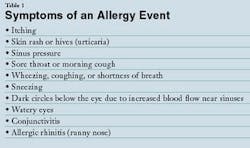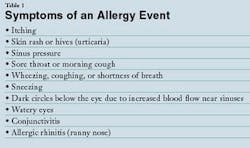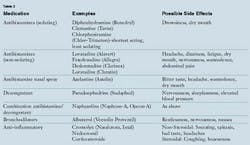Ah-Choo!!!Allergies: The Good, The Bad and The Sneezy
by Sheri B. Doniger, DDS
If that sniffle lasts longer than a week, or you itch after communing with Mother Nature, you may have an allergy creeping up on you.
More than 50 million Americans suffer from some type of allergy, which can be either a seasonal nuisance or a life-threatening experience. Allergies are the sixth leading cause of chronic disease in the United States, impacting the health care system to the tune of $18 million annually. Prevalence estimates are between 9 to 16 percent, marked by a rise in the incidence of allergic rhinitis during the past 15 years. This may be related to the increase in pollutants and the decrease in the ozone level. Allergies affect people of all ages, and those with a family history have a greater chance of developing allergies.
The immune system is the body's defense against substances inhaled or digested, or external substances that come in contact with the body. Increased susceptibility to specific substances constitutes an allergy. When any of these substances cause an allergic response, they are considered an allergen, which cause the immune system to initiate a series of events to rid the body of the offender. The allergen stimulates both cellular and humoral immunity. The usual symptoms, listed in table 1, are the outward signs of the immune system being activated. These symptoms are generated by normally harmless substances that may not affect everyone. Also, if a person is sensitive or allergic to one thing, there is a high probability he or she will be allergic to additional substances.
Cellular immunity, which involves the T-lymphocytes produced in the thymus, activates other parts of the immune system. Humoral immunity involves the antibodies, which are protein components of the blood. There are five different types of antibodies, but IgE is the main one involved in allergic reactions.
Allergens cause the T-lymphocytes to produce IgE antibodies, which attach to the mast cells in the respiratory tract and basophils circulating in the blood. Each allergen has a specific IgE antibody. When a person comes in contact with the allergen, the IgE is sensitized. Each time the allergen is found, the allergen-IgE complex causes the release of histamines from mast cells, which are responsible for the symptoms of the allergic reaction: swelling of the tissues, watery eyes, runny nose, sneezing, and itching. Additional reactions are the release of arachidonic acid from the mast cells that cause release of prostaglandins and leukotrines. Leukotrines are more powerful than histamines in causing airway inflammation and obstruction.
Allergies can be categorized by either their symptom or what symptoms they initiate. All allergies have one thing in common: IgE and the course of events that follow. The severity of the response depends on the person's reaction and not the quantity of allergen that was exposed.
Diagnosing allergies
Allergies are diagnosed through several methods. Three skin tests determine if a person has IgE to specific allergens. Diluted forms of specific allergens are either scratched upon or injected under the skin. A positive reaction would be a wheal or raised reddened area around the site of application within 30 minutes. Skin patch tests check for delayed allergic reactions. These tests, which show a reaction in two to seven days, usually test for metal or chemical allergies. Blood tests can also be used to determine the amount of IgE antibody present to a particular allergen. The radioallergosorbent (RAST) test tests for a large variety of potential allergens but is not very accurate.
Food elimination trials remove foods from the diet one at a time to determine if symptoms are relieved. Recurrent hives or urticaria are sometimes tested for non-allergic etiologies, such as liver or thyroid disease, angioedema, autoimmune diseases such as lupus and other infections. Occasionally, multiple tests need to be utilized to further pinpoint the allergen.
Treatment options
One of the main treatments for allergies is avoidance. Persons with allergies are instructed to avoid contact with the allergen to the best of their ability. But the mere exposure to outdoor air may trigger pollen or mold sensitive individuals. Because someone cannot stay indoors their entire life, adjunct therapies are offered. Allergy shots or immunotherapy was developed in 1911. These are a series of injections given over a period of time to desensitize or modify the immune reaction to specific allergens.
Other treatments calm the inflammatory response. Antihistamines offer symptomatic relief for allergic rhinitis and other allergies. Newer, non-sedating antihistamines offer the same symptomatic relief. Decongestants also offer symptomatic relief by constricting the blood flow to the nasal cavities. They can be either OTC, prescription, liquid, or tablet.
Bronchodilators are used to relieve the respiratory symptoms. Most common are aerosol, tablet, liquid or injectible formulations. Anti-inflammatory agents reduce airway inflammation and are usually inhaled, although corticosteroids may be in an oral or topical formulation. Topical nasal steroids reduce the mast cells in the nose, reduce mucous secretions and decrease nasal swelling. Cromolyn sodium spray, a mast cell stabilizer, is utilized for allergic rhinitis. For some patients, it appears to prevent an allergic reaction by preventing release of histamine from the mast cells.
Some treatments are taken alone or in combination, depending on the severity and etiology of the allergic reaction. Topical steroids may be used for skin reactions. These medications do not come without side effects. Some antihistamines can cause elevated blood pressure. Consult a physician before starting any treatment. Also, drug interactions need to be monitored, especially for patients on multiple medications for various purposes. See Table 2.
Many preventive measures can be taken to avoid allergic reactions. Being proactive, prepared and aware are key. Reviewing medical histories at every visit is imperative.
For patients with a history of anaphylaxis, keep an emergency kit close, and also items such as benedryl, short acting inhalers and an Epi-pen (if necessary). Wearing medic alert bracelets or jewelry could be life saving. Educate family members about the signs and symptoms of an allergic attack and be aware of any possible triggers to an allergic reaction.
Avoidance of the allergens is the best policy, but most people cannot avoid going outdoors or living indoors. A trip to the dentist may cause a variety of allergic reactions. New buildings with high-energy efficiency may trap allergens and pollutants. Bacteria, mold, mildew, and dust mites can hide in upholstery in reception areas. Dust can accumulate in hidden locations. Humidifiers need to be cleaned periodically to prevent mold from forming. "Sick building syndrome" has been associated with various airborne chemicals and solvents, including benzenes, styrenes, and second-hand cigarette smoke. Even though your office may be smoke-free, others in the building may not share your zest for clean lungs.
Several allergens can be avoided with prior knowledge: allergies to latex and medications can be avoided if scrupulous attention to medical history and updates are followed. Children, especially those with spina bifida or who have had multiple surgeries, are more vulnerable to latex allergies.
Question each patient about allergy medication they have taken the day of the visit. When a patient is questioned about medications, they usually do not think of allergy medications in the "mix" of what they feel are important drugs, since many are over-the-counter. To prevent exacerbation of seasonal allergies, windows should be kept closed. We constantly clean our hard surfaces in the treatment and sterilization areas, but we also need to focus on our reception areas. Frequent vacuuming of the floor and upholstery will remove dust mites and any possible animal dander brought in by other patients. A dehumidifier will reduce dust mites and mold.
Xerostomia is a side effect of several medications which could adversely affect the oral soft tissues. Discussions with the patient may include increasing the amount of hydration, and better oral hygiene to prevent increased plaque colonies on drier than normal tissues.
Remember to know what you are allergic to and predict how to avoid contact with the known allergens. Staying informed and being prepared may save a life.
Here are some things to think about in regard to allergies:
• Some foods considered "safe" contain unlabeled food allergens such as milk, peanuts, nuts, eggs, seeds, and wheat.
• Approximately 150 people in the United States die each year from food-related anaphylaxis, and at least 40 die from reactions to insect stings.
• The most allergic flowers are the less colorful ones. Their pollen is small and the plants are wind pollinated.
• Colorful flowers have large pollen that is spread via insects.
• To differentiate between allergies and a common cold, allergy symptoms will occur almost immediately and will last as long as exposure to allergen occurs. A cold will have an incubation time, may include a fever and will be relieved within a week to ten days.
Sheri B. Doniger, DDS, has been in private practice of family and preventive dentistry for 20 years. She is currently focusing on women's health and well-being issues. She can be contacted at (847) 677-1101 or [email protected].
References• www.naiad.nih.gov/factsheets/allergystat.html Accessed 6/1/03
• www.aaaai.org/patients/resources/fastfacts/allergies Accessed 4/25/03
• www.aaai.org/patients/publicedmat/tips/whatisallergicreaction Accessed 4/25/03
• "Types of Allergies" www.intelihealth.com Accessed 4/3/03
• "Allergy Tests" www.intelihealth.com Accessed 5/28/03
• www.naiad.nihgov/publications/allergies/full.html Accessed 6/1/03Resources
• National Institute of Allergies and Infectious Diseases (NIAID), www.niaid.nih.gov
• American Academy of Allergy, Asthma & Immunology, Patient Information and Physician Referral Line: (800) 822-2762, www.aaaai.org
• American College of Allergy, Asthma & Immunology, http://allergy.mcg.edu
• Asthma and Allergy Foundation of America (AAFA), (800) 7-ASTHMA [email protected]
• The Food Allergy & Anaphylaxis Network, (800) 929-4040, [email protected]Allergy Type: Anaphylaxis
The most severe allergic reaction is anaphylaxis. This can cause death in a relatively short time due to the intense reactions of blood pressure drop, swelling in the throat and tongue which obstructs breathing, and airway constriction. Symptoms, which can occur within seconds or minutes of exposure, include wheezing, tightness in the chest, respiratory difficulty, urticaria throughout the body, swelling of the lips and eyes, tachycardia, palpitations, dizziness, nausea, and abdominal pain. Fainting and unconsciousness may occur.
The usual culprits in an anaphalytic reaction are foods (eggs, shellfish, nuts, grains, milk, and peanuts), drugs (such as penicillin, sulfa, and cephalosporin), insect stings (especially bees, yellow jackets, paper wasps, hornets, or fire ants), injected anesthetics (procaine, lidocaine), injected diagnostic dyes, industrial chemicals (latex and rubber), and allergy shots (immunotherapy).
Immediate treatment with epinephrine, either via self-injection with an Epi-pen or in an emergency facility, will save a life. If the Epi-pen is not available, contact 911 immediately.
Allergy Type: RespiratoryRespiratory allergies include allergic rhinitis and asthma. Allergic rhinitis, commonly called hay fever or seasonal allergies, occurs when allergens come in contact with nasal respiratory mucosa. The runny nose and itchy watery eyes are due to the histamine release and the body's inflammatory response to the allergen.
Treatments focus on calming the inflammatory response and blocking histamine from being released.
Asthma develops from airway inflammation. The reaction occurs when no serious infection, toxin, or invading particles begin the inflammatory response in the bronchi. The airways become inflamed due to direct response of the immune system to stimuli which normally would not cause a response. Symptoms include breathlessness, wheezing, and dry persistent cough.
Treatments consist of short- and long-term inhalers to open the bronchial passages and reduce inflammation.
Allergy Type: SkinSkin allergies include hives, atopic dermatitis, and contact dermatitis. Hives consists of itchy erythematous bumps or macules. Scratching makes them increase in size and number due to an additional increase of histamine release.
Although hives does have allergic etiology, it may occur due to infection, heat or cold exposure, or excessive sweating. It can also be triggered by food (most commonly nuts, tomatoes, shellfish, and berries) or medications (penicillin, sulfa, aspirin, and anti-seizure medications). Treatments consist of topical application of corticosteroids and antihistamines.
Eczema is an inflamed skin rash characterized by dry, scaly, and thickened dermis, which may or may not be caused by allergy. Atopic dermatitis is a type of eczema that is allergy-based. Skin exhibits erythematous patches that may have clear exudates or may be dry, raised and scaly. Symptoms usually begin in childhood and become milder with age. These are also treated with topical applications of corticosteroids and antihistamines.
Contact dermatitis occurs when the skin comes in contact with an allergen such as latex, poison ivy, poison oak, poison sumac, metals such as nickel or cobalt, and neomycin. Skin reactions occur two days after exposure and can range from itchy, red, or swollen to fluid-filled vesicles with clear exudate. Treatment consists of a combination of antihistamines and topically applied corticosteroids.
Allergy Type: FoodReactions to food range from intolerance to true allergies. Intolerance is an intestinal symptomatic response to certain foods. Nausea, abdominal pain, migraine and vomiting are not signs of a food allergy, but intolerance to certain foods. MSG (monosodium glutamate), lactose and sulfites are key culprits. Gastroenteritis, or food poisoning, also may be confused with a food allergy, but it is from a bacterial toxin or contaminated food. This is usually a one-time event due to undercooked or ill-prepared food.
True food allergies are very common, affecting 1 percent of adults, 8 percent of preschool children, and 2 percent of older school-age children.
Allergies to peanuts and nut oils (specifically walnuts or cashews) affect more than three million Americans and cause the most severe reactions. For this reason, most airlines have stopped distributing nuts on flights.
Other causes of food allergy include: cow's milk (in infants), eggs, wheat or grains, soy, and a variety of fish and shellfish. True allergic reactions to food usually begin within minutes of digesting the offending item, as compared to an intolerance or gastroenteritis, which may exhibit symptoms hours later.
Children have a tendency to outgrow some allergies, although some are persistent, such as nuts and fish. Symptoms include diarrhea, nausea, vomiting, tingling, swelling, and itching of the lips, mouth and throat with urticaria. If severe, anaphylaxis may occur.
Allergy Type: EnvironmentalEnvironmental allergies include insect venom bites and airborne particulate matter. Chemical sensitivity to various compounds, both organic and inorganic, may mimic allergic reactions but do not elicit the IgE response as a true allergy.
Allergy to insect venom is common, affecting approximately 3.3 percent of Americans. Stings from a bee, hornet, or wasp may cause anaphylaxis. Reactions include a spreading rash, urticaria, and swelling of the hands and face. Emergency treatment may be needed. Some patients carry an Epi-pen.
Airborne allergies to particulate dust, mold, pollen, and animal dander are common. The allergy is not to the pets, but to the protein from the oil glands in the animal's skin that is shed in dander and the protein in saliva. Cats are more allergenic than dogs because they clean themselves more, are more house bound, and are usually held more than dogs. Symptoms such as sneezing, itchy, watery eyes and runny nose are common. Reactions to these airborne allergens range from allergic rhinitis, otis media, sinusitis and asthma.
Treatment depends on the severity and exacerbation of the allergy.
Allergy Type: MedicationMedication allergies are particularly important because any adverse reaction to medications may alter therapy for a specific treatment. Medications do have side effects which are different from allergies. A patient may believe he or she is allergic to Novocain, but they actually had only an adverse reaction to the injection process. It is important to question patients on the type and duration of reaction experienced with any drug. A patient who has a side effect to a certain drug may be able to take a pharmacologically related drug, but not so with an allergy. With an allergy, the reaction will occur across the entire class of medication and may lead to anaphylaxis.
Signs of a drug allergy include rash, itch, tightness in the throat, or breathing difficulty. Treatment includes discontinuing the medication and depends on the severity of symptoms.


